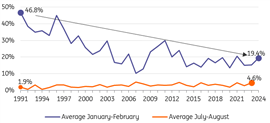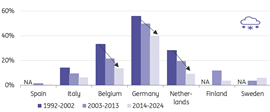Are mild winters helping European construction efficiency?
23 April 2024
Across the globe, regional winter cycles are seen as down periods for construction productivity, but a new report from Dutch financial institution ING suggested the European market has ticked up efficiency amid the cold seasons.
 Construction workers navigate a winter site. (Image: Adobe Stock)
Construction workers navigate a winter site. (Image: Adobe Stock)
“Warmer winter weather means European construction contractors are experiencing less business disruption as our climate warms,” said ING senior economist Maurice van Sante in the report titled Construction companies see efficiency gains due to milder winters.
Offering data compiled by ING Research, NASA, and Our World in Data, van Sante noted that temperature anomalies in the Northern Hemisphere reached heights nearly two degrees (Celsius) higher, on average, than in 1985.
“We wanted to see if rising temperatures have already had a measurable impact on European construction companies’ annual production cycles,” said van Sante, noting that two indicators were used in measurement:
- The share of companies that mention their production levels were limited during the winter (January and February) and summer (July and August) periods due to weather conditions
- The variation of the actual construction volumes in these periods
What the research found was a more than 30% reduction of EU contractors, over the last three decades, who said their activities were restricted due to bad weather from January to February.
“In 1991, almost 50% of EU contractors said their activities were restricted due to bad weather,” said van Sante. “This share decreased gradually to less than 20% during these winter months in 2024.
 Data and graph courtesy Eurostat, ING Research
Data and graph courtesy Eurostat, ING Research
“So, we find a clear decline in winter weather issues in the construction sector, which could be attributed to rising temperatures.”
He said the sharpest decline in winter complaints came from Belgium, Germany and the Netherlands.
“In Germany in the [1990s], more than 55% of the contractors complained about winter weather,” he said. “This has decreased to less than 40% in the last ten years.”
Van Sante said the EU construction sector has ‘clearly’ become more productive over the past decades during the months of January and February.
“Between 1995 and 1999, average construction volumes then were 22% below the annual average. This has decreased to 13% between 2019 and 2023,” he said. “Fewer weather disturbances during the winter months make construction 9% more productive during these two months, which is a yearly gain of 1.5%.”
Some like it hot? Sweltering summers a non-issue for European construction
While gains in productivity in winter could be seen as a positive, the rising global temperatures – overall – are not.
Yet, van Sante said a reciprocal loss of productivity in summer (from heat or extreme weather) is simply not occurring in a measurable way.
However, he did note that record highs in the summertime are increasing the frequency of cancelled work days.
“Where building companies have cited fewer complaints about disturbing winter weather, the opposite is true during the summer period (July and August),” said van Sante, adding that the change was ‘less profound’.
Van Sante said in 1991, 2% of EU contractors complained about summer weather conditions compared to 4.6% who cited weather as a problem in 2023.
“Although it’s still quite marginal, more contractors are experiencing weather-related issues in the summer,” said van Sante. “The average production decline was much smaller in July and August. The impact of climate change is still hardly noticeable there.”
Temperature isn’t everything as contractors are better prepared for winter conditions
An anomaly in the report showed that Europe’s northern countries – somewhat surprisingly – consistently log fewer complaints about winter weather compared to their southern counterparts.
“Contractors in Finland and Sweden have, in general, always had fewer issues with weather conditions than Germany, Belgium and the Netherlands,” explained van Sante.
He said the ING team found three possible reasons for the discrepancy:
- Building companies active in cold areas of Europe invest in special winter equipment so that construction can go on because their winters are colder and last longer. For instance, their transport vehicles have winter tyres or even spikes.
- More production activities are indoors (prefab) to cope with long periods of darkness and cold weather.
- With project planning, they already take into account that certain building activities, such as excavation works, are just not feasible during the winter. They plan these during the summer, which makes disturbances due to frozen ground less common.
 Data and graph courtesy Eurostat, ING Research
Data and graph courtesy Eurostat, ING Research
In the continent’s hottest regions, the same type of weather resilience (compared to northern countries in the winter) is observed in the summer.
“Extreme heat can make working outside impossible,” noted van Sante. “Yet, Spanish contractors don’t complain as much about hot weather during the summer months of July and August. Like Swedish and Finnish contractors, during the winter, they likely adjust their building plans to the summer heat, making them less vulnerable to productivity losses.”
Summer construction productivity loss not just about heat
But it’s not just sweltering temperatures that disrupt summer activity.
In fact, van Sante suggested that record heat had a ‘marginal’ effect on recent years’ loss of productivity in the industry.
“A changing climate also influences river water levels,” he explained. “Low water in the summer poses a risk of supply chain disruption as many heavy building materials, such as sand and gravel, are often transported by barges, which sometimes can’t be loaded to full capacity, and routes are also simply cancelled.
“Those low water levels are presumably what’s causing the marginal increase in summer disruptions,” he concluded.
Rising temps offsetting labour issues
The change in weather, said van Sante, has actually been an aid to what’s been a historically smaller labour pool.
“Well over 14 million people work in the EU construction industry. This means that a 1.5% productivity increase results in more than 200,000 fewer workers needed,” said van Sante. “Without that productivity increase, structural labour shortages in the construction sector would have been even bigger than they are today.”
Symptoms are silver linings, not positive harbingers
While it may seem like a warming planet has created an ideal environment for construction activities in some sections of the Northern Hemisphere, van Sante cautioned in his report that these changes are diamonds in what has become an increasingly rough environment.
“We need to be absolutely clear that climate change is not a positive thing,” he said.
STAY CONNECTED



Receive the information you need when you need it through our world-leading magazines, newsletters and daily briefings.
CONNECT WITH THE TEAM








